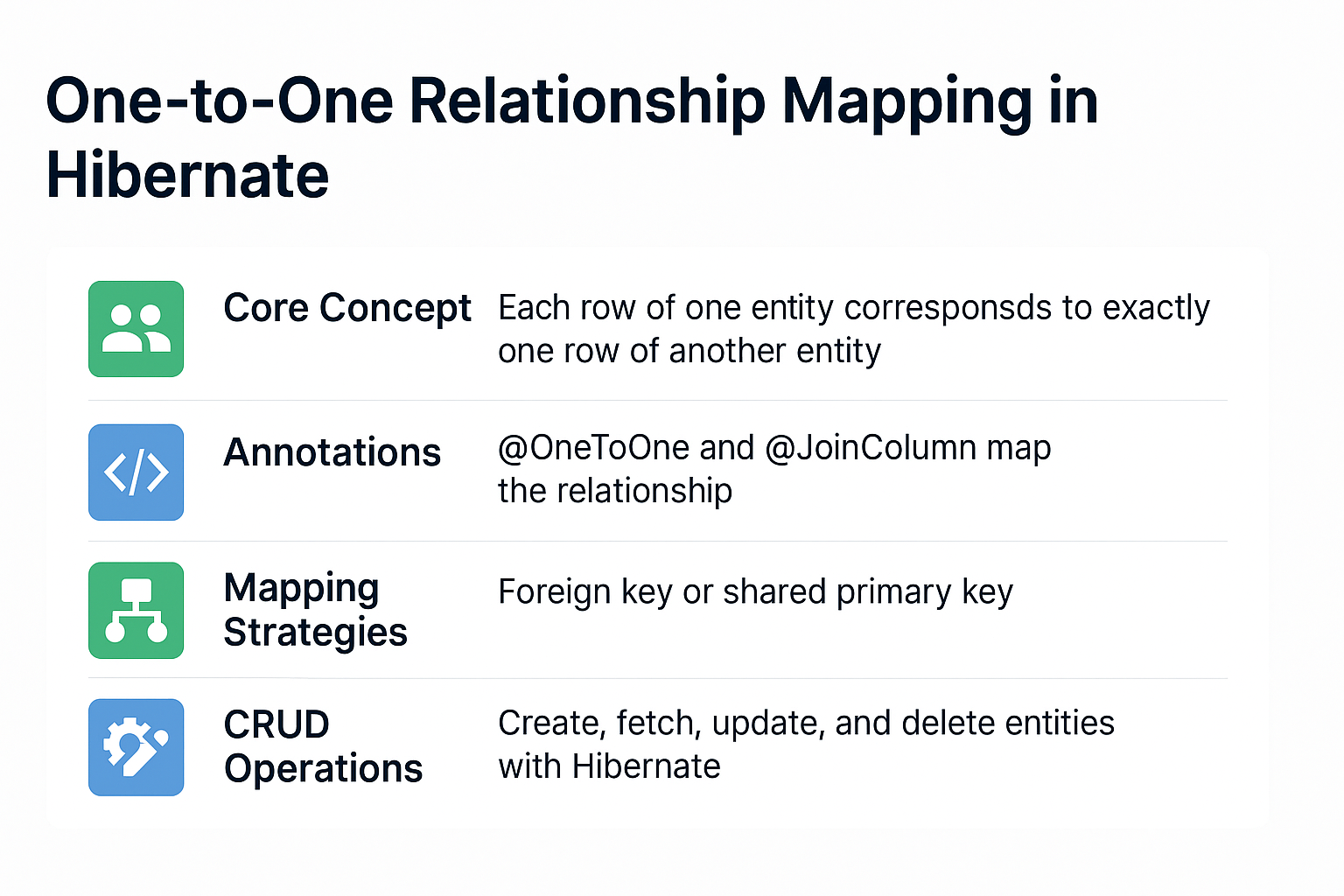In modern enterprise applications, data relationships are inevitable. For instance, a User may have a Profile, or an Employee may have a ParkingSpot. These are real-world one-to-one relationships — one record in a table corresponds exactly to one record in another.
Hibernate, as a powerful ORM (Object-Relational Mapping) framework, makes handling these relationships intuitive and less error-prone. Instead of writing raw SQL joins, Hibernate provides annotations and mappings that abstract the complexity, allowing developers to focus on business logic.
In this tutorial, we’ll explore everything you need to know about One-to-One Relationship Mapping in Hibernate, complete with practical examples, performance considerations, and best practices.
Core Definition and Purpose
A one-to-one relationship in Hibernate means that each row of one entity corresponds to exactly one row of another entity.
Example:
- User ↔ Profile
EveryUserhas oneProfile, and everyProfilebelongs to exactly oneUser.
Hibernate helps achieve this with minimal boilerplate using:
@OneToOneannotation@JoinColumnor@PrimaryKeyJoinColumnfor join strategies
Required Setup and Configuration
Maven Dependencies
<dependency>
<groupId>org.hibernate.orm</groupId>
<artifactId>hibernate-core</artifactId>
<version>6.2.2.Final</version>
</dependency>
<dependency>
<groupId>org.postgresql</groupId>
<artifactId>postgresql</artifactId>
<version>42.5.0</version>
</dependency>
Hibernate Configuration (hibernate.cfg.xml)
<hibernate-configuration>
<session-factory>
<property name="hibernate.connection.driver_class">org.postgresql.Driver</property>
<property name="hibernate.connection.url">jdbc:postgresql://localhost:5432/testdb</property>
<property name="hibernate.connection.username">postgres</property>
<property name="hibernate.connection.password">password</property>
<property name="hibernate.dialect">org.hibernate.dialect.PostgreSQLDialect</property>
<property name="hibernate.hbm2ddl.auto">update</property>
<property name="show_sql">true</property>
<mapping class="com.example.User"/>
<mapping class="com.example.Profile"/>
</session-factory>
</hibernate-configuration>
Mapping Strategies
Hibernate supports two primary strategies for one-to-one mapping:
-
Using Foreign Key (most common)
- One entity holds a foreign key reference to the other.
-
Using Shared Primary Key
- Both entities share the same primary key.
Example 1: One-to-One Using Foreign Key
@Entity
@Table(name = "users")
public class User {
@Id
@GeneratedValue(strategy = GenerationType.IDENTITY)
private Long id;
private String username;
@OneToOne(cascade = CascadeType.ALL)
@JoinColumn(name = "profile_id", referencedColumnName = "id")
private Profile profile;
}
@Entity
@Table(name = "profiles")
public class Profile {
@Id
@GeneratedValue(strategy = GenerationType.IDENTITY)
private Long id;
private String bio;
}
This creates a foreign key (profile_id) in the users table.
Example 2: One-to-One Using Shared Primary Key
@Entity
@Table(name = "users")
public class User {
@Id
@GeneratedValue(strategy = GenerationType.IDENTITY)
private Long id;
private String username;
@OneToOne(mappedBy = "user", cascade = CascadeType.ALL)
private Profile profile;
}
@Entity
@Table(name = "profiles")
public class Profile {
@Id
private Long id;
private String bio;
@OneToOne
@MapsId
@JoinColumn(name = "id")
private User user;
}
Here, both User and Profile share the same primary key.
CRUD Operations Example
Create and Persist Entities
Session session = sessionFactory.openSession();
Transaction tx = session.beginTransaction();
User user = new User();
user.setUsername("john_doe");
Profile profile = new Profile();
profile.setBio("Software Engineer");
user.setProfile(profile);
session.persist(user);
tx.commit();
session.close();
Fetch Entity with Profile
Session session = sessionFactory.openSession();
User user = session.get(User.class, 1L);
System.out.println(user.getUsername() + " -> " + user.getProfile().getBio());
session.close();
Update Profile
Session session = sessionFactory.openSession();
Transaction tx = session.beginTransaction();
User user = session.get(User.class, 1L);
user.getProfile().setBio("Senior Software Engineer");
tx.commit();
session.close();
Delete User and Cascade Profile
Session session = sessionFactory.openSession();
Transaction tx = session.beginTransaction();
User user = session.get(User.class, 1L);
session.remove(user);
tx.commit();
session.close();
Querying with Hibernate
Using HQL
List<User> users = session.createQuery("FROM User u WHERE u.profile.bio LIKE :bio", User.class)
.setParameter("bio", "%Engineer%")
.getResultList();
Using Criteria API
CriteriaBuilder cb = session.getCriteriaBuilder();
CriteriaQuery<User> cq = cb.createQuery(User.class);
Root<User> root = cq.from(User.class);
cq.select(root).where(cb.equal(root.get("profile").get("bio"), "Software Engineer"));
List<User> users = session.createQuery(cq).getResultList();
Caching, Fetching, and Performance
- Lazy Loading (default): Profile is loaded only when accessed.
(Analogy: like ordering food only when you’re hungry.) - Eager Loading: Profile loads with User — can cause N+1 problem if used incorrectly.
- Second-Level Cache: Store entities in cache to avoid redundant queries.
Real-World Use Cases
- User ↔ Profile
- Employee ↔ ParkingSpot
- Customer ↔ Address
In enterprise systems, this ensures normalized database design and simplifies maintenance.
Anti-Patterns and Common Pitfalls
- Using Eager Fetching unnecessarily → performance bottlenecks.
- Not configuring cascade properly → orphan records.
- Choosing shared primary key mapping when foreign key mapping suffices.
Best Practices
- Prefer foreign key mapping for flexibility.
- Use lazy loading unless eager fetching is explicitly needed.
- Always manage transactions properly.
- Enable caching in read-heavy applications.
📌 Hibernate Version Notes
Hibernate 5.x
- Legacy
SessionFactoryconfiguration. - JPA 2.1 namespace.
- Traditional HQL/Criteria API.
Hibernate 6.x
- Jakarta Persistence (
jakarta.persistence). - Improved SQL query support.
- Simplified
SessionFactorybootstrapping. - More powerful Criteria API.
Conclusion and Key Takeaways
- Hibernate makes one-to-one mapping straightforward using annotations.
- Two approaches: foreign key and shared primary key.
- Always optimize fetching and caching for performance.
- Choose strategies based on use case and scalability.
FAQ
Q1: What’s the difference between Hibernate and JPA?
Hibernate is an ORM framework; JPA is a specification. Hibernate is one implementation of JPA.
Q2: How does Hibernate caching improve performance?
By reducing database hits using first-level and second-level cache.
Q3: What are the drawbacks of eager fetching?
It can load unnecessary data, causing performance degradation (N+1 select problem).
Q4: How do I solve the N+1 select problem in Hibernate?
Use JOIN FETCH in HQL or batch fetching strategies.
Q5: Can I use Hibernate without Spring?
Yes, Hibernate can work standalone with just its configuration.
Q6: What’s the best strategy for inheritance mapping?
Depends on use case: SINGLE_TABLE for performance, JOINED for normalization.
Q7: How does Hibernate handle composite keys?
Using @EmbeddedId or @IdClass annotations.
Q8: How is Hibernate 6 different from Hibernate 5?
Hibernate 6 uses Jakarta namespaces and enhanced query support.
Q9: Is Hibernate suitable for microservices?
Yes, but prefer lightweight DTOs and avoid heavy session management.
Q10: When should I not use Hibernate?
When dealing with extremely high-performance, low-latency applications requiring raw SQL control.
